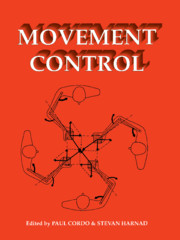Book contents
- Frontmatter
- Contents
- Preface
- 1 Does the nervous system use equilibrium-point control to guide single and multiple joint movements?
- 2 Does the nervous system depend on kinesthetic information to control natural limb movements?
- 3 Can sense be made of spinal interneuron circuits?
- 4 Implications of neural networks for how we think about brain function
- 5 Do cortical and basal ganglionic motor areas use “motor programs” to control movement?
- 6 Functional heterogeneity with structural homogeneity: How does the cerebellum operate?
- 7 Are movement parameters recognizably coded in the activity of single neurons?
- 8 The representation of egocentric space in the posterior parietal cortex
- Open Peer Commentary and Authors' Responses
- References
- Index
Open Peer Commentary and Authors' Responses
Published online by Cambridge University Press: 11 December 2009
- Frontmatter
- Contents
- Preface
- 1 Does the nervous system use equilibrium-point control to guide single and multiple joint movements?
- 2 Does the nervous system depend on kinesthetic information to control natural limb movements?
- 3 Can sense be made of spinal interneuron circuits?
- 4 Implications of neural networks for how we think about brain function
- 5 Do cortical and basal ganglionic motor areas use “motor programs” to control movement?
- 6 Functional heterogeneity with structural homogeneity: How does the cerebellum operate?
- 7 Are movement parameters recognizably coded in the activity of single neurons?
- 8 The representation of egocentric space in the posterior parietal cortex
- Open Peer Commentary and Authors' Responses
- References
- Index
Summary
Commentaries submitted by the qualified professional readership of this journal will be considered for publication in a later issue as Continuing Commentary on these articles. Integrative overviews and syntheses are especially encouraged.
How does the nervous system control the equilibrium trajectory?
[EB] The classical monkey limb perturbation experiments of Bizzi et al. (1982; 1984) greatly influenced motor control studies. Their findings, as well as those of Asatryan and Feldman (1965) on the unloading of the human forearm, were in good agreement with Feldman's hypothesis that the nervous system controls limb movements not by programming EMG bursts or force pulses for the limb acceleration and deceleration, but by defining a new equilibrium of the “limb/external load” system. In their target article, however, Bizzi et al. reject the concrete neurophysiological mechanism proposed by Feldman for how the system's equilibrium position is controlled.
Alpha-lambda controversy. It is suggested by Bizzi et al. that the X model is a subset of the a model, because the former uses a concrete form of the relationship between joint angle, central control parameters, and the level of a activity. They also reject the necessity of a muscle invariant characteristic for an equilibrium point (EP) model and argue that “the reflex apparatus contributes in a modest way to force generation” (see, however, Gandevia & Burke, this issue).
- Type
- Chapter
- Information
- Movement Control , pp. 99 - 242Publisher: Cambridge University PressPrint publication year: 1994



